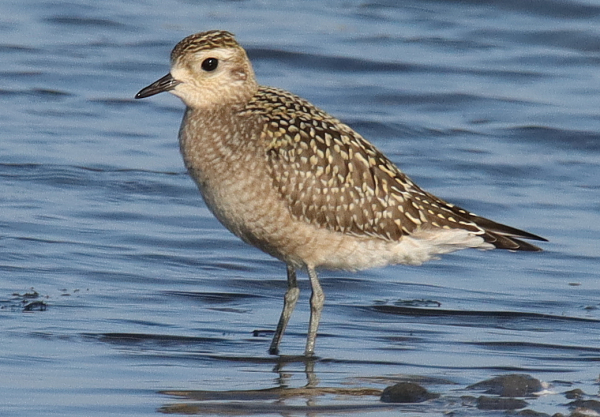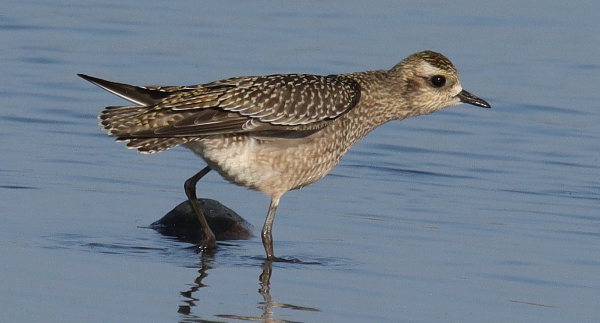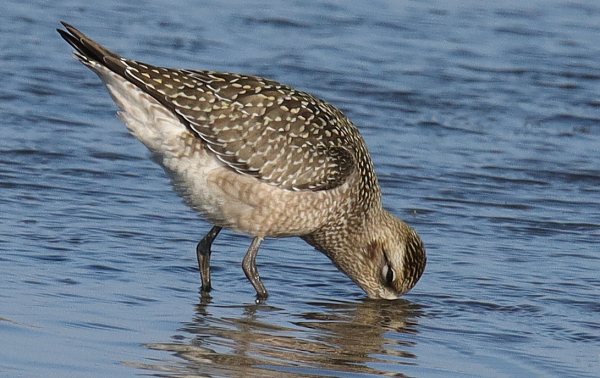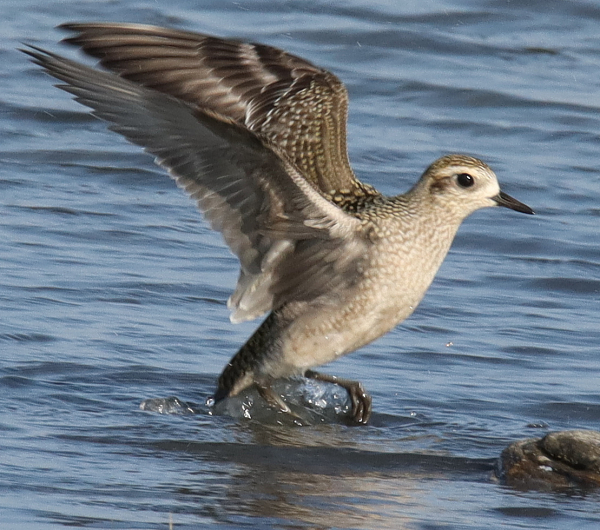Would you call it a once in a lifetime chance? So far, yes, that’s the case: I found a flock of birds that represented a personal first. After arriving at Charo Marsh, there were no birds to hold my attention at my primary photo stop, but I eased forward about 60 yards to another little bay that has become more promising lately. There were many Killdeer gathered there, but the outline of a couple other birds caught my attention. Grabbing my binoculars, I focused on 3 American Golden Plovers! And as I scanned more of the shoreline, more and more Golden Plovers were evident, amounting to 10 in all scattered among 20 Killdeer.

The light was right, as was the time of day to get a 60-degree angle of sunlight from behind my position to provide prime lighting for plover photos. As always in good sunlight, I had my camera preset at ISO 400 and f-8, which I left unchanged. The resulting shutter speeds of 1/1000 and 1/1250 were fast enough for the action I witnessed, so during the exciting half-hour I spent with the plovers, I could focus on the birds rather than on my camera settings.

This flock of American Golden Plovers was obviously resting, some lying down and some standing with their head resting on their back – all except one. That plover was quite animated, wading in the sky blue water, then drinking and bathing, followed by a shoreline search for food. Other Goldens soon began activating, and began following the first plover’s lead. The appearance of other plovers along the wetland shore created a number of aggressive interactions, with one plover chasing another, and an occasional Golden chasing a Killdeer. There was also more bathing and I tried to get some action photos in addition to some nice portraits of these plovers during a rare fall stopover in rural Dakota.
How rare? A decade ago I observed a flock of American Golden Plovers in northern Wisconsin, and I observed a trio of molting adults 2 weeks earlier – in this exact same location. Those were my only 2 fall observations of this species, which is understandable considering that most American Golden Plovers migrate east from their Arctic nesting range, then south along the Atlantic Coast on their way to South America. Some American Goldens do filter through the central part of the continent during fall, which is the species’ normal spring migration route, but to find these birds in the same location 2 weeks apart a dozen miles from my office – that’s rare.

I enjoyed observing the plovers for about a half-hour, managing much better photographs than I took of the adults weeks earlier. The sleek-looking plovers were actually quite a distance away, near the limit of where I could realistically get good photos of the birds. But using the full magnification of my 150-to-600mm Tamron zoom lens, the resulting photos were impressively sharp enough to enlarge a bit more, simply by cropping some extraneous background from selected photographs using the photo editing program (Paintshop Pro) I use on my computer.

After bathing, a split-second wing flap provided a chance for an action photo that shows the long pointed wings of an American Golden Plover (600mm zoom, f-8 aperture, 1/1000 shutter speed, ISO 400).
|
By coincidence, the 3 adult Golden Plovers that I observed 14 days earlier were found in this exact location; at least I think it was coincidental. I documented the adults in mid-molt, as they were transitioning from alternate (breeding) plumage to basic (winter) plumage. When I found the flock of 10 Goldens exactly 2 weeks later, it appeared all the plovers were in full basic plumage, showing no more black or gold among their feathers. But when I took a closer look at the enlarged photos of the birds on my laptop, it was clear they were all young Goldens making a stopover during their first fall migration. They were in juvenile plumage, which is very similar to basic plumage of the adults. Juvenile plumage is most easily distinguished by showing more patterned coloration on their breast and belly feathers; adults in basic plumage show a lighter unpatterned underside and a prominent white line above their eyes.
Considering these plovers were all recent fledglings, it’s fair to say the young Goldens were following 2 weeks behind the molting adults that I encountered in this very same location. The birds were most likely not related, just different age groups migrating at different times. I checked the referenced information provided in Birds of the World, which verified that adult American Golden Plovers migrate earlier than juveniles. Adults generally migrate during August and juveniles migrate from late August to early October.

After savoring a half-hour with the plovers on the edge of a remote Dakota wetland, with no real indication or apparent reason, the 10 Goldens suddenly lifted off, formed a tight flock, and flew to the southeast – just like the adults – seemingly as they began another leg of their migration (or were they simply flying to the next marsh – I can’t say for certain). This memorable birding episode certainly stands out, and it emphasizes one of the reasons we are birders – we are looking for the next treasure, because it’s such a thrill when a “golden” treasure appears before us and we have the chance to take photographs to remember and share the experience with others.
Article and photographs by Paul Konrad
Share your bird photos and birding experiences at editorstbw2@gmail.com